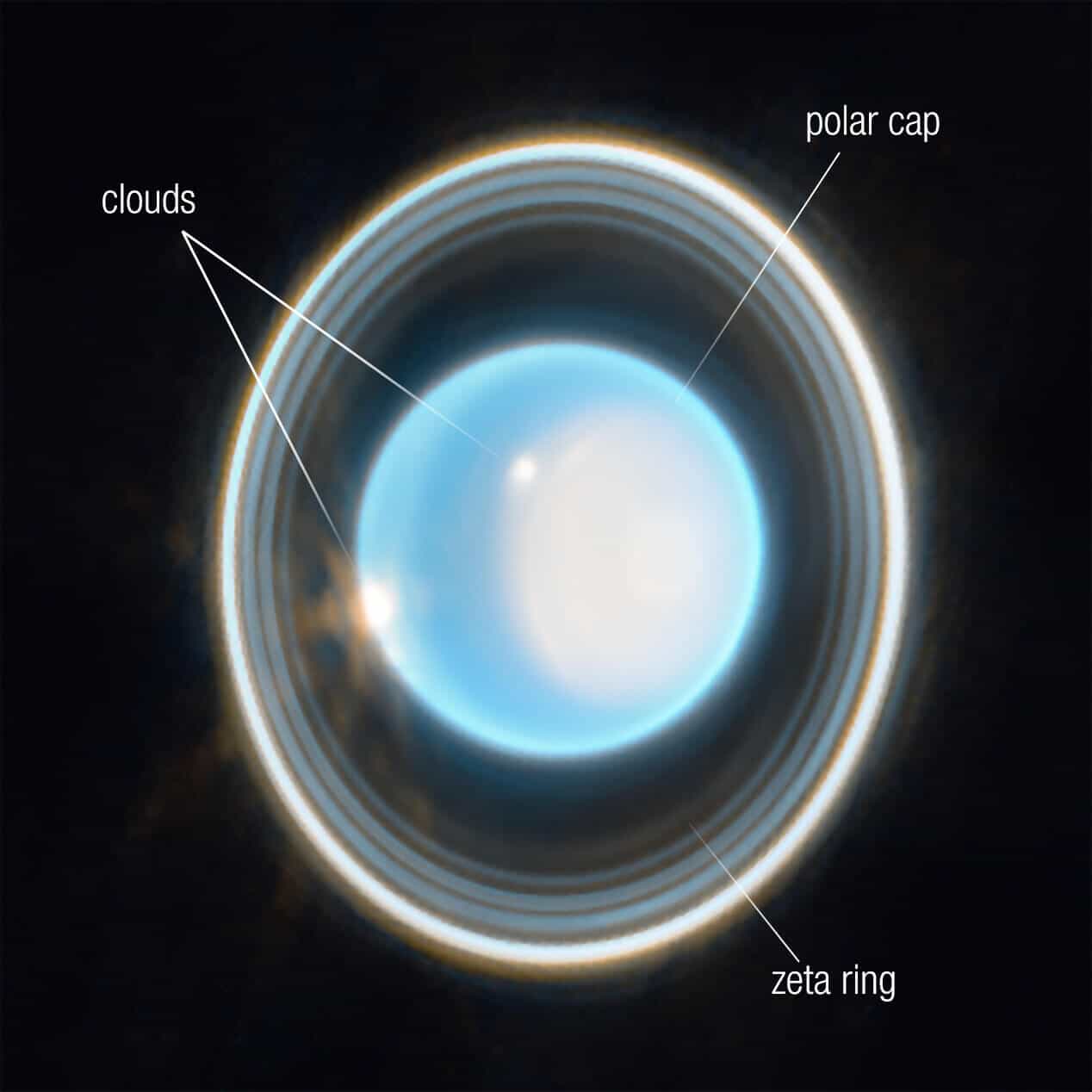Infrared imaging of Webb highlights the planet's dramatic rings and dynamic atmosphere

The "James Webb" space telescope took an amazing picture of the second ice giant in the solar system, the planet Uranus-Uron. The new image shows for the first time in detail the large rings that both Uranus and Saturn have, as well as bright components in the planet's atmosphere. Webb's data demonstrate the telescope's unprecedented sensitivity by revealing the faintest dusty rings previously imaged by only two other instruments: the Voyager 2 spacecraft that flew past the planet in 1986, and the Keck Observatory which used advanced adaptive optics.
Uranus-Uron, the seventh planet from the Sun, is unique: it rotates on its side, at an angle of almost 90 degrees from the plane of its orbit. This causes extreme seasons because the planet's poles experience many years of constant sunlight followed by an equal number of years of total darkness. (Uranus takes 84 years to orbit the Sun). Currently, we are at the end of spring at the North Pole, which can be seen in the photograph; Uranus' northern summer will begin in 2028. However, when Voyager 2 visited Uranus it was summer at the south pole. The South Pole is now on the shadow side of the planet, out of sight and facing the darkness of space.
This infrared imaging from the Web's near infrared wavelength camera (NIRCam) combines data from two 1.4 and 3.0 micron filters, shown here in blue and orange, respectively. The planet shows a blue tint in the image obtained with a representative color.
When Voyager 2 observed Uranus, it revealed a blue-green sphere almost featureless in visible wavelengths. At infrared wavelengths, and with the greater sensitivity of the 'web', we see more detail, showing just how dynamic Uranus' atmosphere really is.
On the right side of the planet is an area of brightening at the pole facing the sun, known as the polar dome. This polar dome is unique to Uranus - it seems to appear when the pole enters direct sunlight in the summer and disappears in the fall; This Web data will help scientists understand the currently mysterious mechanism behind this feature. 'Web' revealed a surprising aspect of the polar dome: a subtle and enhanced brightening in the center of the dome. The sensitivity of Webb's NIRCam and the longer wavelengths it can see may explain why we can see this enhanced polar feature of Uranus when it has not been seen by other powerful telescopes such as the Hubble Space Telescope and Keck Observatory.
At the edge of the polar dome is a bright cloud and you can see some pale extended features just beyond the edge of the dome; A very bright second cloud is visible on the left limb of the planet. Such clouds are characteristic of Uranus at infrared wavelengths, and are probably associated with storm activity in the atmosphere.
This planet is considered an ice giant because of the chemical composition of the interior of the structure. Most of its mass is considered to be a dense liquid of "frozen" substances - water, methane and ammonia - above a small rocky core.
Uranus has 13 known rings and 11 of them are visible in this Webb image. Some of these rings are so bright as seen by the Web, that when they are close together, they appear to merge into a larger ring. Nine of these are classified as the planet's main rings, and two are the fainter dusty rings (like the diffuse zeta ring closest to the planet) that were only discovered in 1986 by Voyager 2. Scientists predict that future 'web' images of Uranus will reveal the The two pale outer rings discovered by 'Hubble' during the crossing of the plane of the ring in 2007.
'Webb' also photographed many of the 27 known moons of Uranus (most of which are too small and faint to be seen in this photograph); The six brightest are identified in the widescreen image. This was just a short exposure image (12 minutes) of Uranus with only two filters. The new data provided by the Webb Space Telescope is just the tip of the iceberg of what Webb can do when observing this mysterious planet. Additional studies of Uranus are currently taking place, and additional studies are planned during the first year of Webb's scientific activity.
More of the topic in Hayadan:

3 תגובות
To complete the picture, point the telescope towards Neptune and photograph its rings. will open a basis for comparative studies between these two ring systems.
How many are your works, God! Lest they say, Our hand is crooked, and Yahweh has not done all this.
In the hope that WEB will also photograph the rings of Neptune and following this will come comparative studies between the rings of these two planets.